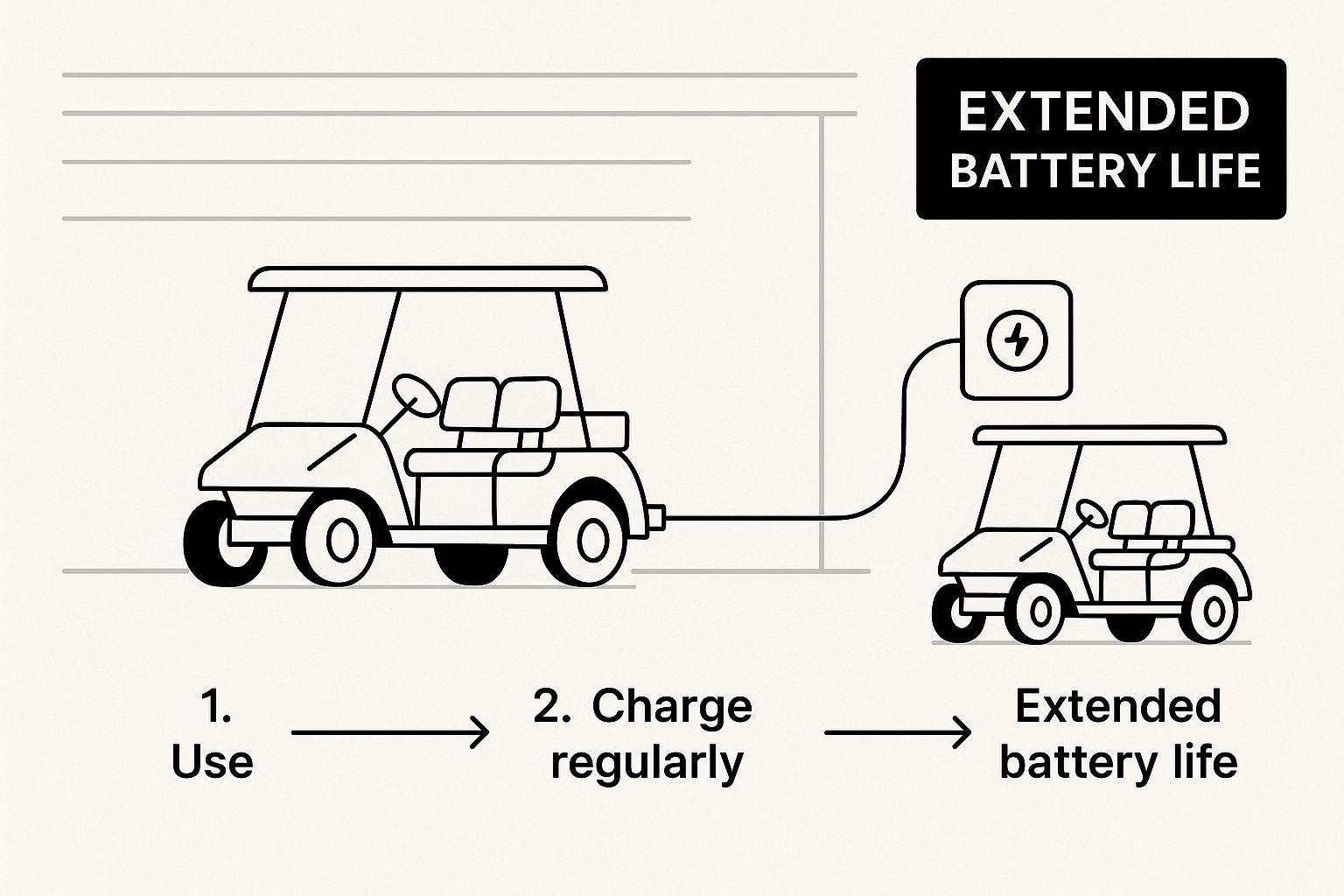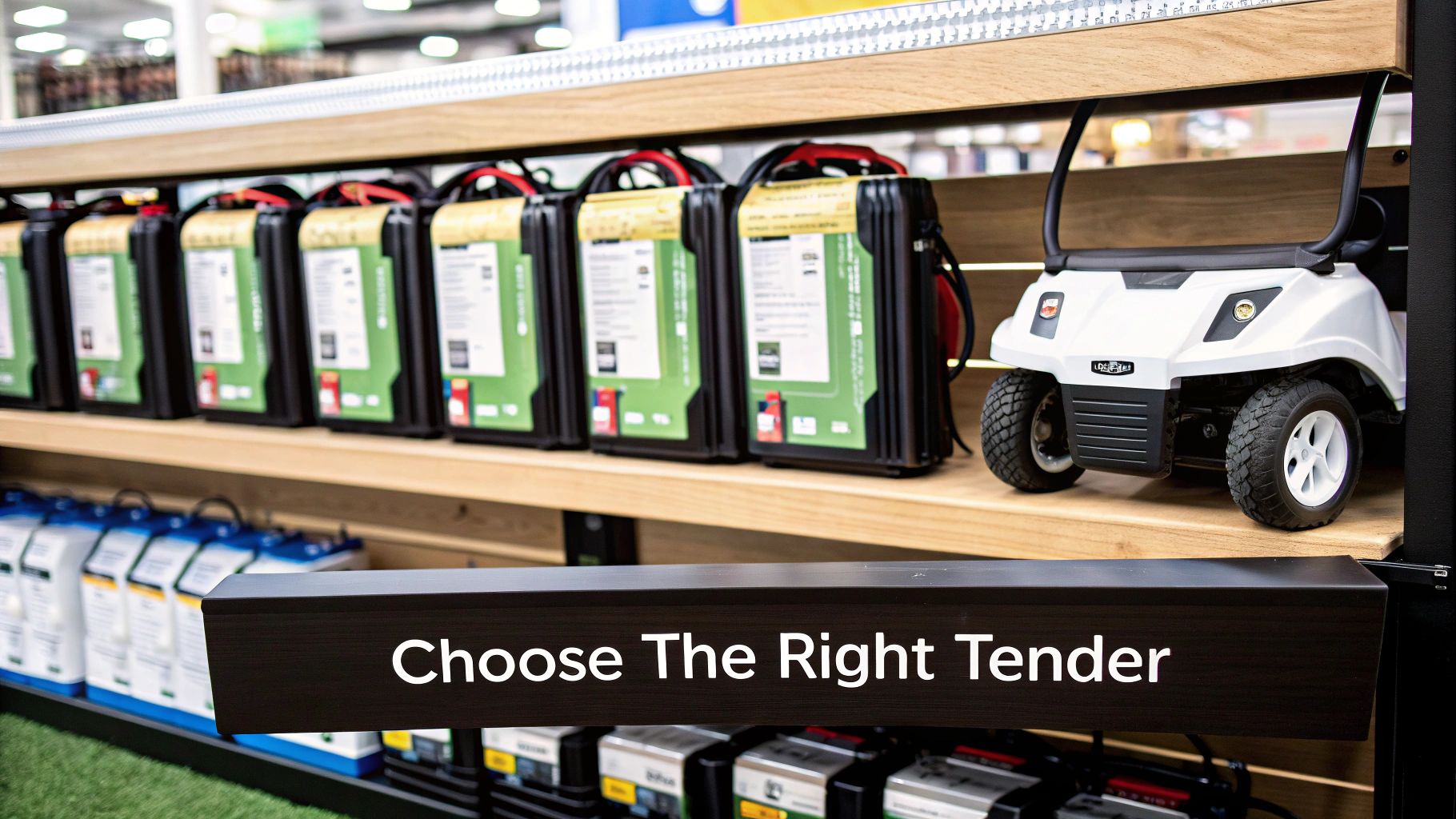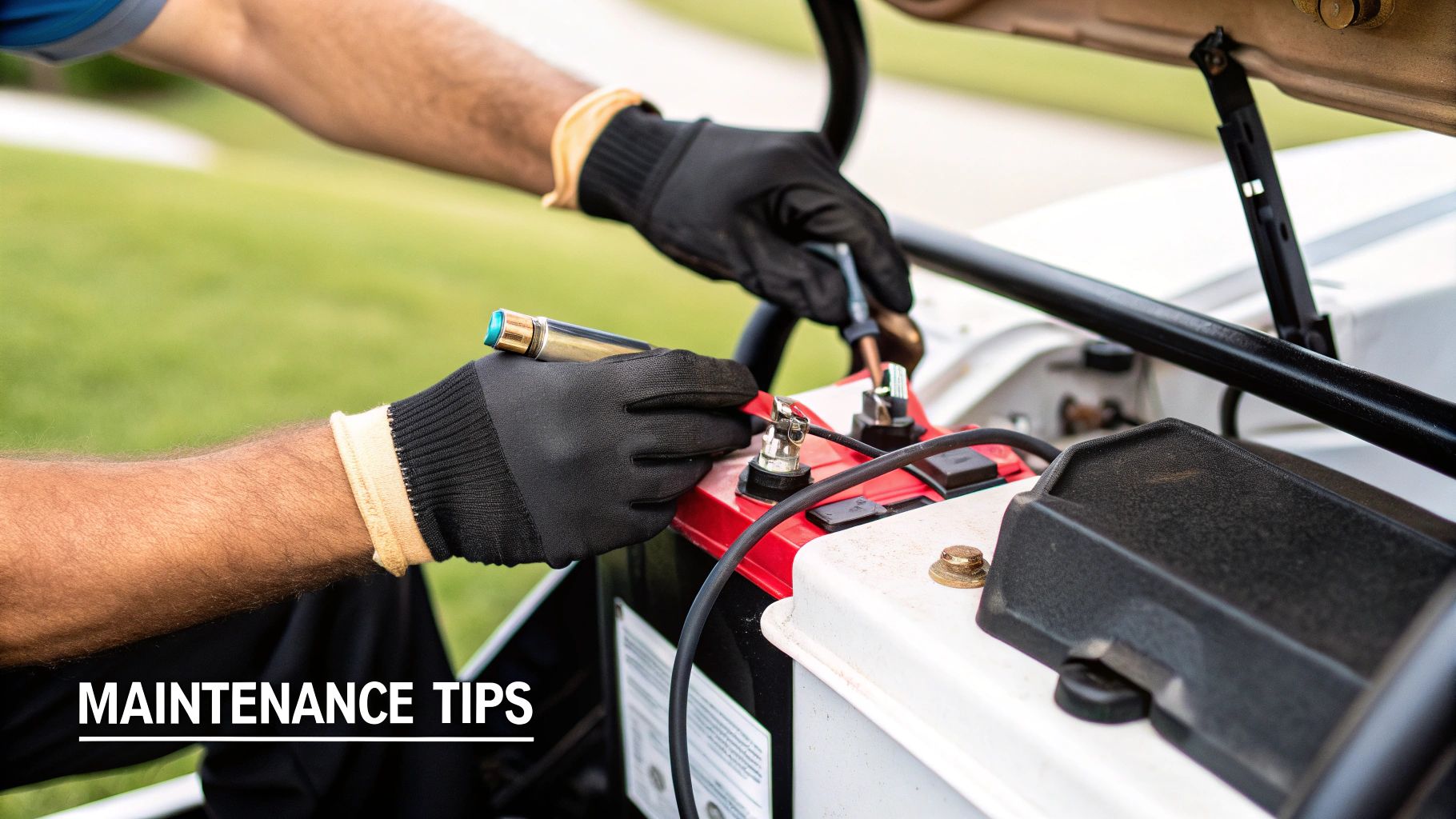A battery tender is one of those small, smart devices that quietly saves you a ton of money and headaches. Essentially, it delivers a slow, steady stream of low-amperage power to your golf cart's batteries, keeping them perfectly topped off when you're not using them.
Think of it as a 'maintenance diet' for your battery. It's not about rapid charging; it's about preventing the natural charge loss that happens over time and protecting the expensive deep-cycle batteries that power your cart.
Why Your Golf Cart Needs a Battery Tender
Let's use an analogy. Imagine your golf cart's battery is a marathon runner. A standard charger is like a huge pasta dinner after the race—it’s designed to quickly refill a depleted energy source. A battery tender, on the other hand, is the daily nutrition plan that keeps the runner in peak condition, always ready for the next run.
Without that daily maintenance, the battery slowly bleeds its charge. This is especially true for golf carts, which can sit unused for days or even weeks. During this downtime, a silent killer called sulfation starts to creep in. This is when lead sulfate crystals build up on the battery plates, choking their ability to hold a charge. A battery tender stops this process cold by keeping the battery at its ideal voltage.
The Real Cost of Neglect
Let's be blunt: ignoring battery maintenance is an expensive mistake. The batteries in your cart are a serious investment, and they're the heart of a massive industry. In fact, the global golf cart battery market was valued at around USD 184.45 million and is expected to climb to USD 273.74 million by 2032. As more people invest in carts, knowing how to protect that investment becomes crucial.
A simple way to compare these two devices is to look at their core jobs.
Battery Tender vs Standard Charger at a Glance
This table breaks down the fundamental differences between a battery tender (or maintainer) and a standard golf cart charger.
| Feature | Battery Tender (Maintainer) | Standard Charger |
|---|---|---|
| Primary Function | Maintains a full charge; prevents self-discharge. | Rapidly recharges a depleted battery after use. |
| Ideal Use Case | Long-term storage, off-season, or infrequent use. | Daily or regular charging between rounds. |
While a standard charger is for recovery, a tender is for prevention. Both are important, but they serve very different purposes.
A high-quality battery tender is one of the most cost-effective forms of insurance you can buy for your golf cart. It turns a potential recurring expense—premature battery replacement—into a predictable, one-time purchase.
Ultimately, using a tender means your cart is always ready to go when you are. No more showing up for a tee time only to find a dead battery. This principle of readiness applies to all kinds of battery systems; for example, it's the same logic behind maintaining readiness for battery backup systems in a home.
To get a better idea of how long your batteries should last with proper care, check out our guide on the lifespan of golf cart batteries.
Understanding Smart Charging Technology
So, what’s the big deal with “smart” technology in a modern battery tender for a golf cart? It all comes down to a tiny microprocessor—the brains of the operation—that acts like a dedicated caretaker for your batteries. Think of it like a smart thermostat for your home; instead of just blasting heat or AC, it intelligently monitors the temperature and adjusts as needed.
This little chip does the same thing for your battery, constantly checking its voltage and fine-tuning the electrical current. This prevents the two silent killers of expensive deep-cycle batteries: overcharging and undercharging. Overcharging can literally boil the electrolyte inside, while letting the battery sit undercharged leads to damaging sulfation. A smart tender sidesteps both issues, which is why you can leave your cart plugged in for weeks or even months at a time without a single worry.
The Multi-Stage Charging Process
This intelligent charging isn't just a simple on/off switch. It’s a sophisticated, multi-stage process designed to gently bring your battery back to peak health and keep it there. While the specifics can vary by brand, most follow a similar sequence:
- Initialization: First, the tender does a quick health check. It assesses the battery's current voltage and condition to map out the best charging strategy.
- Bulk Charge: This is the heavy-lifting phase. The tender supplies the maximum safe current to quickly get the battery up to about 80% capacity.
- Absorption Mode: Once it hits that 80% mark, the charger slows things down. It holds the voltage steady but gradually tapers off the current, allowing the battery to safely "absorb" the final charge all the way to 100%.
- Float/Maintenance Mode: Here's the magic for long-term storage. After the battery is fully charged, the tender switches to a low-power "float" mode. It just provides a tiny trickle of energy to counteract the battery's natural self-discharge, keeping it perfectly topped off and ready to go.
This infographic does a great job of showing how this hands-off process is the key to getting the most life out of your golf cart's power source.

As you can see, that automated float mode is what really makes a difference for long-term battery health, doing all the work so you don't have to.
How to Choose the Right Battery Tender
Picking the right battery tender for your golf cart isn't as simple as grabbing the first one you see on the shelf. It’s about making a smart match between the technology in the tender and the specific needs of your cart. This is what protects your investment. A standard car battery tender just won’t do the job—your cart's heavy-duty, deep-cycle batteries need a maintainer built for their unique demands.
First things first, you have to know your cart's total system voltage. Golf carts usually run on 36V, 48V, or 72V systems, and the tender you choose must match that number perfectly. Trying to use a 12V car tender on a 48V system is like trying to fill a swimming pool with a water pistol. It’s totally ineffective and might even cause damage.

Match the Chemistry and Features
Next up is your battery chemistry. The way you care for a traditional lead-acid battery is completely different from how you treat an AGM or a modern lithium model. And that shift to newer battery types is happening fast. In fact, lithium-ion batteries now make up around 47.18% of the revenue in the golf cart battery market. They're the fastest-growing option out there, mostly because they last so long and work so efficiently.
Always choose a battery tender that is explicitly compatible with your battery type—lead-acid, AGM, or lithium. A mismatch can lead to undercharging, overcharging, or permanent damage, voiding your battery's warranty.
Beyond getting the basics right, there are a few key features you should look for to guarantee safety and top-notch performance:
- Temperature Compensation: This is a huge one. It adjusts the charging voltage based on the surrounding temperature, which stops your batteries from getting damaged in extreme heat or cold.
- Multi-Voltage Support: Some of the more advanced tenders can automatically figure out the system voltage and adjust accordingly. This is super handy if you have more than one cart with different setups.
- Key Safety Certifications: Keep an eye out for features like spark-proof connectors and reverse polarity protection. These are lifesavers, preventing accidents if you accidentally hook up the clamps the wrong way.
Making the right choice here protects your batteries and ensures your cart is ready to roll whenever you are. For a deeper dive into the chargers themselves, you might want to check out our guide on choosing a charger for an electric golf cart.
A Step-by-Step Guide to Safely Using Your Tender
Hooking up a battery tender to your golf cart is pretty simple, but getting the sequence right is non-negotiable for safety. Just a few key steps will keep you safe and make sure your batteries get the full benefit of that maintenance charge.
First things first, give your setup a quick once-over. Take a look at the battery terminals for any crusty corrosion and check the cables for cracks or fraying. You'll also want to work in a well-ventilated spot, like your garage with the door open. This lets any hydrogen gas—a normal part of charging lead-acid batteries—safely dissipate. And hey, throwing on some safety glasses is never a bad idea.
The Connection Sequence
This is the most important part of the whole process. Connecting the clamps in the right order prevents sparks, which is the last thing you want around a battery.
- Kill the Power: Before anything touches your battery, make sure the tender is completely unplugged from the wall. No exceptions.
- Connect the Positive (Red) Clamp: Clamp the red clip firmly onto the main positive terminal of your golf cart's battery bank. You want a solid, wiggle-free connection.
- Connect the Negative (Black) Clamp: Now, attach the black clamp to the main negative terminal of the battery bank.
- Plug It In: Only after both clamps are securely connected should you plug the tender into the wall outlet and switch it on.
By plugging in the tender last, you completely remove the risk of creating a spark right next to the batteries. It’s a simple habit that’s at the heart of smart battery care.
Once it's powered up, glance at the indicator lights. Nearly every tender has LEDs that confirm you've got a good connection and show whether it's in charging or float mode. This little confirmation tells you everything is working as it should, so you can walk away confident your batteries are being looked after—whether for a few days between rounds or all winter long.
The Long-Term Benefits of Using a Tender
Using a battery tender for your golf cart is one of the smartest decisions you can make as an owner. Don't think of it as just another expense; see it as an investment that pays you back by protecting the single most expensive component on your cart: the battery bank.
The biggest payoff is a dramatically longer battery lifespan. By preventing the deep discharge cycles and sulfation that kill batteries, a good tender can often double the effective life of your set. That simple act of maintenance means you're not shelling out hundreds—or even thousands—of dollars on premature replacements. It's a game-changer.
This proactive care also means your cart is always ready to go when you are, eliminating that sinking feeling of finding a dead battery right when you want to head out.

Maximizing Your Investment
The real value here becomes obvious when you look at the different types of batteries carts use. Capacities can range anywhere from under 25 Ah to well over 100 Ah. Those high-performance carts, especially the ones built for longer run times or heavier loads, are often running powerful batteries in the 50 to 100 Ah range. Protecting that kind of investment is just common sense.
A quality tender pays for itself the very first time it saves you from buying a new set of batteries. It's a fundamental part of a smart maintenance routine.
Want to dig deeper into the advantages of a well-maintained power system? It's worth reading about how advanced battery technology can save time and money. For more practical tips, don't miss our complete guide to golf cart battery maintenance.
Common Questions About Golf Cart Battery Tenders
Even after you're sold on the benefits, it's natural to have a few questions about how a battery tender fits into your daily routine. Getting straight answers helps you use your battery tender for a golf cart with confidence, making sure you're protecting that big investment sitting in your garage.
Let's clear up some of the most common questions that pop up.
Can I Leave a Battery Tender Connected All the Time?
Yes, you absolutely can. In fact, that’s exactly what modern "smart" tenders are designed for. Once your cart’s batteries are topped off, the tender automatically switches over to a "float" or maintenance mode.
Think of it like this: the tender delivers just a tiny trickle of power to counteract the battery's natural self-discharge. It’s a bit like keeping a bucket of water full by letting a slow drip replace what evaporates. This prevents the damaging effects of overcharging while ensuring the battery is always at 100% and ready to go. You can safely leave it plugged in for weeks or even months during the off-season without a second thought.
Modern battery tenders aren't just chargers; they're intelligent battery minders. Their "set it and forget it" design is their biggest selling point, giving you total peace of mind during long-term storage without any risk of cooking your batteries.
This smart technology is a massive leap from the old-school "trickle chargers" that could easily overcharge and destroy a battery if left connected for too long. To be safe, always stick with a modern, multi-stage smart tender.
Will a Tender Charge a Dead Golf Cart Battery?
Generally, no. A battery tender's main job is maintenance, not a full-blown rescue mission. It’s built to keep a healthy, already-charged battery in peak condition by sending it a very low-amperage current.
If your golf cart batteries are completely flat, a tender simply doesn't have the muscle to bring them back to life. For that kind of heavy lifting, you'll need a proper multi-stage battery charger. A tender is for keeping a full tank from evaporating; a charger is for filling an empty tank from zero.
Once a dedicated charger has done the hard work of restoring the bulk charge, then you can switch over to the tender for long-term upkeep.
Do I Need a Special Tender for Lithium Batteries?
Yes, and this is a big one. You absolutely must use a tender specifically designed for lithium batteries. Their internal chemistry is completely different from traditional lead-acid batteries, and they have very specific charging needs.
Trying to use a standard lead-acid tender on a lithium battery is a recipe for disaster. It can cause serious damage and even create a safety hazard. Always look for a battery tender that is explicitly labeled for lithium-ion (Li-ion) or lithium-iron-phosphate (LiFePO4) chemistry. These models have the right charging algorithms to safely manage lithium cells.
Using the wrong charger is one of the quickest ways to ruin a very expensive lithium battery bank, so always double-check the compatibility before you plug anything in.
Ready to walk your course with less effort and more enjoyment? The Caddie Wheel electric power assist system is the perfect upgrade for your push cart, giving you motorized control for up to 36 holes. Learn more and get yours today at https://caddiewheel.com.


Share:
Top Charger for Electric Golf Cart | Ultimate Guide & Tips
Choosing Your Golf Push Pull Cart